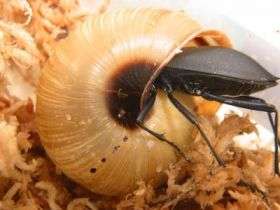A carabid beetle inserting its head into a snail shell. Credit: photograph by J. Konuma
Large jaws are efficient in crushing hard prey, whereas small jaws are functional in capturing elusive prey. Researchers have suggested that such trade-offs between “force” and “velocity” could cause evolutionary diversification of morphology in animals such as birds, fish, and salamanders.
Junji Konuma and Satoshi Chiba of Tohoku University found that a new trade-off exists in animal feeding behavior. The team suggests that diversification of carabid beetles could be caused by a “force” and “fit” trade-off.
There are both elongate, small-headed and stout, large-headed carabid beetles that feed upon land snails. Large-headed beetles can readily crush snail shells with their powerful jaws, but cannot insert their oversized heads into the shells. In contrast, small-headed beetles can insert their heads into the shells for direct predation on snail bodies, but poorly crush the shells because of their frugal jaws.
“Crushing and inserting are alternatively effective in feeding on snails,” said Konuma. Carabid beetles that feed on snails tend to have an extremely slender or stout forebody compared with beetles that eat insects and earthworms. Phylogenetic studies show that adaptations for snail feeding led to the diversification of beetle heads.
Interestingly, it has been demonstrated that the same trade-off diversifies shell morphology in studies of freshwater snails, where elongate shells are adaptive in protecting against entry attacks and rounded shells are adaptive in protecting against crushing attacks. “Trade-offs between force and fit have a significant, important role in both morphologies of snails and snail predators in evolution,” said Konuma.
Source: University of Chicago
























